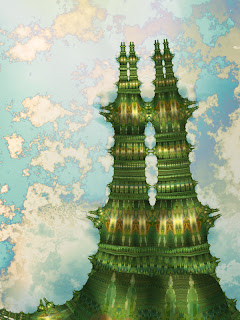There's always a sort of jarring transition when I've been out looking at natural phenomena for a while, and then look at fractals, and the fractals all of a sudden seem much too simple and perfect, and I despair of ever making anything that looks half as cool as the stuff that's outside. Over the years, I've tried to make fractal clouds, and fractal spectra, and fractal plants, and none of them is ever as good as the real kind. But they are, I suppose, interesting in their own way, and so I persist.
One of the kinds of crystals that can happen is called a scepter. (Some more nice scepter pictures here.) I only found one small example of this shape while I was digging, and sadly it was full of internal fractures, so much so that it started to break apart while I attempted to brush sand off it. But the name made me think of a silly pun, so I came home and made a picture to go with it. So, from the mountains of Montana, and the Scepter Valley of the Mandelbrot set:
Amethyst Scepter





